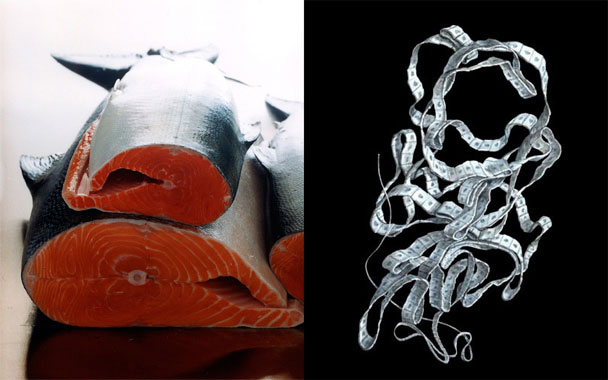Salmon tartare—eye-catching, fun, hip and tasty—has become a popular menu item in many top restaurants. Celebrity chefs prepare it on television. Mainstream magazines, newspapers, and cookbooks feature recipes. Raw salmon dishes—tartare, crudo, sushi, marinated and cured salmon—are growing in popularity. But unless that fish has been frozen first, it would be wise to pass.
That’s because a tiny tapeworm larva may lurk in the raw salmon flesh, just waiting for you to eat it so that it can take up residence in your digestive tract. Diphyllobothrium latum, carried by freshwater fish (including anadromous wild salmon, which spend their early lives in fresh water), is the largest human tapeworm. After the larva is ingested by a fish-eating mammal, it hooks onto the small intestine, where it grows to maturity, freeloading on its host for nutrients (it has a special affinity for Vitamin B12). Cooking fish or freezing it at minus-31 degrees Fahrenheit or colder for 15 hours will kill Diphyllobothrium larvae. Marinating will not. Freezing fish at slightly higher temperatures for longer periods will also kill the larvae but will likely diminish the quality of the fish.
Just this week, a Chicago man sued a well-known local restaurant for $100,000, claiming that he had acquired a nine-foot tapeworm from an undercooked salmon salad in 2006. (The restaurant’s parent company, LEYE, says the restaurant was cleared in the incident by a 2006 Chicago Health Department investigation.) It’s the first case of tapeworm infection to make the news in a while, and that lack of media coverage—combined with the growing popularity of sushi over the past few decades—may help explain the prevalence of raw fish dishes in recent years. (Ironically, Japanese chefs, at least those who have passed the exam that is required for opening a restaurant in Japan, never serve fresh salmon raw or lightly seared—“has to be frozen for sushi,” stresses sushi master Shiro Kashiba, of Shiro’s Sushi Restaurant in Seattle.)
Chefs who offer raw salmon today are no doubt unaware of the 1980s press—like these articles by Mimi Sheraton in The New York Times—about outbreaks of Diphyllobothrium latum infection (known as diphyllobothriasis) and the risks associated with eating raw or undercooked salmon. In the fall of 1980 there were 36 known cases of diphyllobothriasis on the East Coast attributed to raw salmon. In the same year, the CDC issued an advisory after four medical doctors in Los Angeles acquired tapeworms from salmon sushi. In 1984, 17 people in the aptly named village of King Salmon, Alaska acquired tapeworms from eating salmon ceviche prepared from a recipe supplied by a visitor from California.
It’s unclear how many cases of diphyllobothriasis there are today: The Centers for Disease Control and Prevention in Atlanta are aware that such infections happen, but according to the CDC’s Susan Montgomery, “there is no systematic reporting of cases in the U.S.”
While diphyllobothriasis is not life threatening, the tapeworm can grow up to 30 feet long and live for decades, sometimes causing anemia from B12 depletion. Most diphyllobothriasis cases are initially asymptomatic, so they often go undetected; people can live with a tapeworm for years without knowing they have one. Some make the unhappy discovery after passing a segment in their stool. Others learn of their cohort after seeking treatment for symptoms such as diarrhea, abdominal cramping, fatigue, and nausea. (Such was the case with Jeff Smith, aka The Frugal Gourmet, one of the first celebrity TV chefs, who confided to writer Alicia Arter during an interview in 1992 that he was being treated for an “enormous tapeworm” he said he got from eating salmon sushi made from salmon that had not been frozen.) If a physician relates these symptoms to the possibility of tapeworm infection, a diagnosis is made and the infection is treated with a prescription medication.
But if a physician has not had a tapeworm patient before, the diagnosis can be challenging. In 2006, a doctor described in The New York Times how his medical partner couldn’t figure out what was causing his normally energetic wife’s fatigue and, as blood tests showed, anemia. There were no gastrointestinal symptoms. The correct diagnosis came when a colleague, after learning that the patient tasted her fresh gefilte fish as she seasoned it before cooking, suggested she might have a tapeworm. (Diphyllobothriasis is sometimes referred to as “Jewish housewives’ disease” for that reason.) Bingo! Diphyllobothrium latum. After treatment, the patient discharged the parasite—a three-foot-long specimen.
How likely is it that the salmon you’re eating contains a tapeworm? According to Tammy Burton, a fish pathologist for the Alaska Department of Fish and Game, the levels of infestation fluctuate seasonally and from year to year, but in general Diphyllobothrium latum is “fairly common” in Alaska salmon. In its Bad Bug Book, the FDA warns that farmed salmon, if they spend time in fresh water, can also acquire the larvae. Farmed salmon from Chile, where juvenile salmon are grown in cages in freshwater lakes, have been implicated in diphyllobothriasis outbreaks in Brazil and elsewhere.
So a better question is: How likely is it that you will get a tapeworm if you eat raw, unfrozen salmon that contains a tapeworm larva? According to Phillip Klesius, research leader at the USDA Aquatic Animal Health Research Laboratory in Auburn, Alabama, “The consumption of one live larva can result in tapeworm infection.” So until you find out if that salmon has been frozen first, it would be best to hold your fork.


